Welcome to day 2 of CamundaCon!
We hope you’re as excited as we are for CamundaCon 2023! After an incredible day 1, day 2 of the conference starts today, and we’ll be bringing you the latest updates from the event live on this blog post as they’re happening. Be sure to check back often as we’ll be updating this post throughout the day.
We’ve officially sold out the venue, but if you couldn’t join us in person in New York City, you can still catch all the sessions online for free! Just register at the link below, check out the agenda and make sure you don’t miss a thing. We’ll see you there, whether online or in person!
Update: Did you miss CamundaCon, or just want to check out the sessions you couldn’t catch live? All replays are now available at the link below!
Morning run with Bernd
Ready to go before the morning keynote? At 6:30am ET today Bernd led a morning run with a number of CamundaCon attendees – for those bold enough to join (which did not include me), what a refreshing way to start the morning!
If you joined (or even if you didn’t), share your thoughts over on social!
Almost time!

The countdown has begun to the welcome and opening keynote!
Welcome

Once again, Camunda’s Amy Johnston welcomed us all to the conference. After a reminder of how to join the Selfie Screen (tag your selfies with #camundacon and #selfie to join!), the best way to navigate the two tracks tracks and highlights of key speakers along with our AMA and sponsor booths, she welcomed Camunda co-founder and Chief Technologist Bernd Rücker and Camunda CTO Daniel Meyer to the stage.
Opening Keynote Bernd Rücker & Daniel Meyer, Camunda
After a cool video of the morning run you see above, Bernd Rücker and Daniel Meyer took us through some of the typical challenges in financial services (and other industries) when it comes to understanding your processes. Old code in COBOL, lots of complex human interactions… it can be hard, and the result can be a slow customer experience (like the 6 weeks Bernd said it took him to recently open a bank account at a large bank in Germany.)
A first step is to at least track your processes.
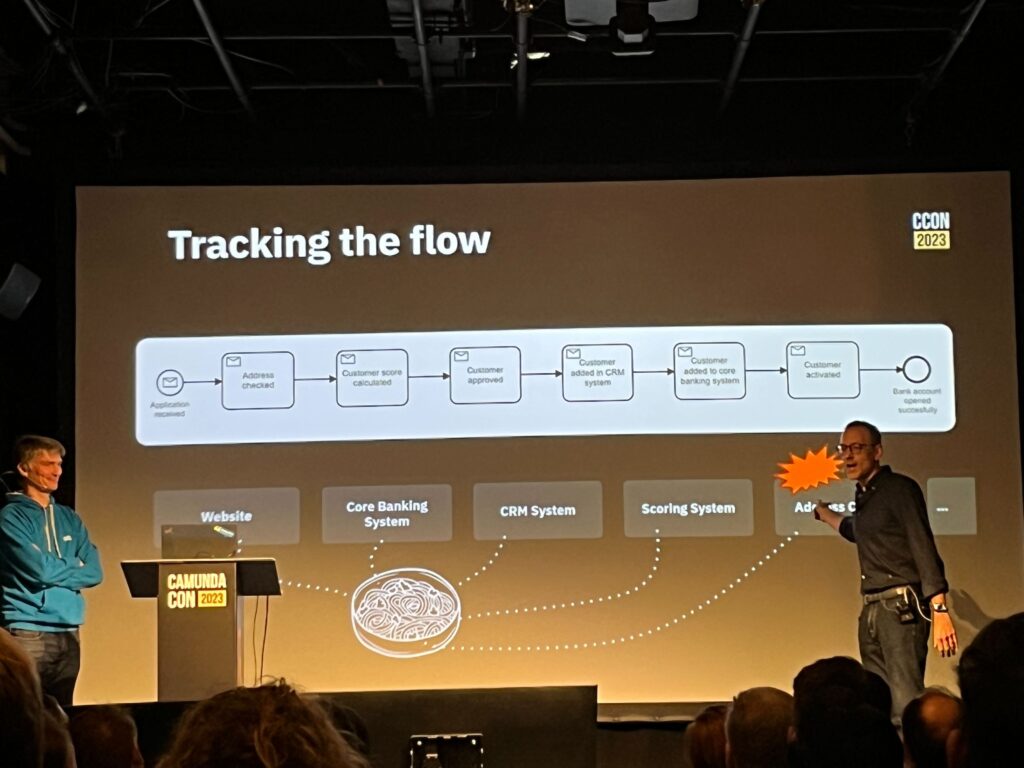
But then as you start orchestrating, you’ve got to “get your hands deep in the spaghetti” as Bernd put it on stage, and continuously improve.

Daniel explained the bigger picture around the benefits of orchestration maturity. As has been discussed in other sessions yesterday, scaling adoption, implementing a Center of Excellence, reusing processes and connectors and more can dramatically increase the value of your process orchestration and automation.
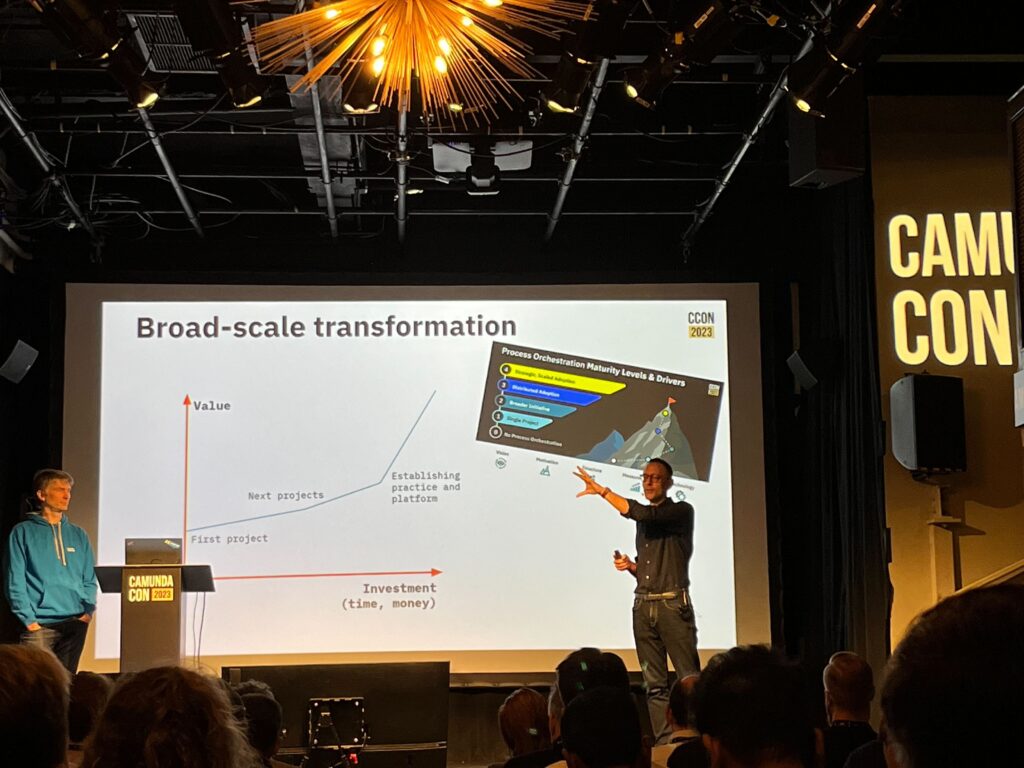
Bernd then took us through a live demo of one place that can make it easy to reuse something like a Camunda Connector – the new Camunda Marketplace. It was very cool to see how quickly he was able to download a Connector, add it into a new BPMN model in Modeler, test it out with Play and just like that, he had a verified working Connector in his project! There are already 61 Connectors in the Marketplace from Camunda, partners and the amazing Camunda community. Bernd shared how Connectors are relatively easy to create – and anyone can submit their own to the Marketplace and share it with others.
Bernd went on to share his thoughts on the best way to organize systems and teams to facilitate high-performance and maturity, considering how to balance centralization vs autonomy (particularly regarding microservices). He explained that full autonomy for isolated teams won’t give you an ideally optimized end-to-end process.
Next Daniel helped us understand how to think about the value of understanding your automation use cases and how to enable the right team members for the task. Doing this can help break down those familiar silos between business users and IT.
Camunda features like Play, Form Builder and TaskList can empower more users to work on more tasks. Bernd quickly demonstrated how easily a new process could be modeled and deployed using those tools with minimal code. This helps even more users get involved in automation so you can scale automation goals faster and more successfully without relying completely on IT.
AI also helps this too. Daniel explained different approaches and uses for AI, including a new project called BPMN-GPT that uses generative AI to create a process model in BPMN.

Bernd also shared an important note about the importance of high-throughput, low-latency and resiliency in process performance – he noted that even though it hasn’t been shared too much, it’s still a central part of Camunda that is continuing to be improved. He definitely didn’t want to leave it out!
Hello to our global audience!
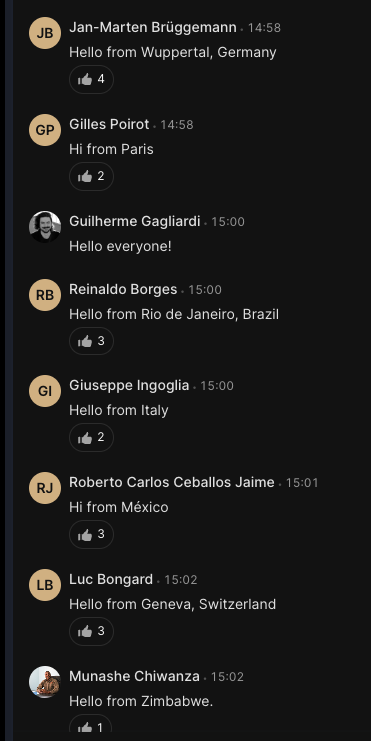
A bit earlier as the event kicked off online many of our online attendees said hello and shared where they’re from. Welcome all 👋 and thanks for joining!
Automating Citizen Services in the City of Munich
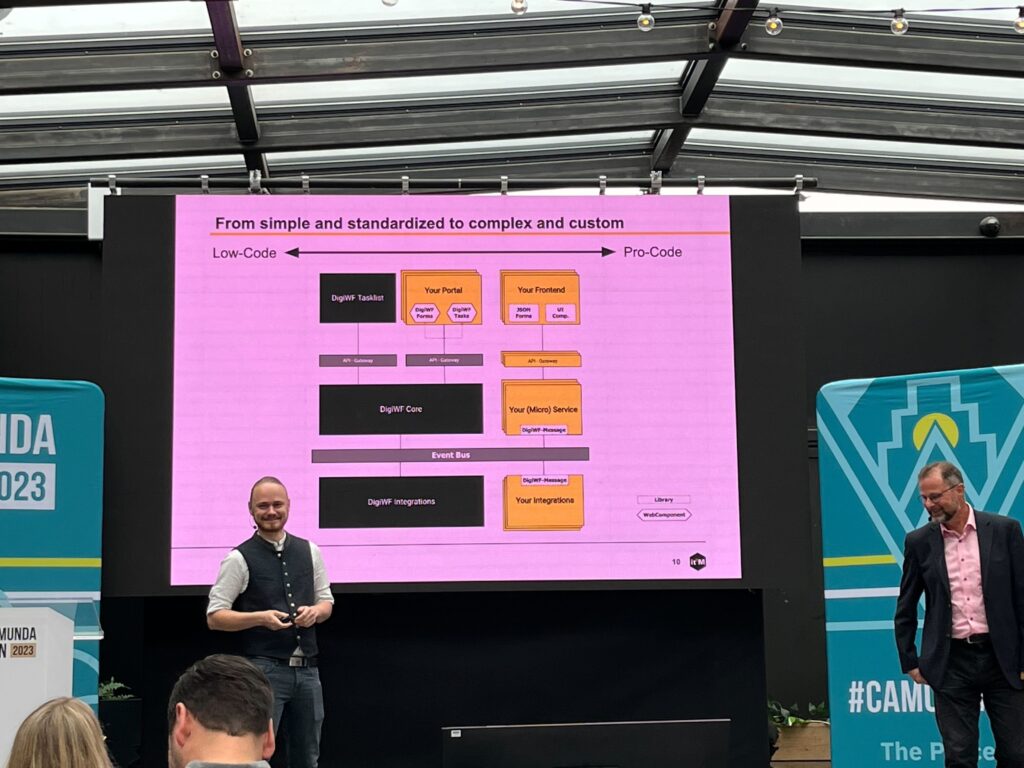
Next, I headed up to the roof to hear about how the City of Munich helps automate citizen services. Dirk Gernhardt & Rene Zarwel explained that Munich has over 1.5 million citizens and is the biggest municipal service provider in Germany, with numerous departments and service providers to manage. At the same time, expectations are very high from users across the technical spectrum.
Their solution, which I captured in the picture above, was to create a variety of systems using Camunda that span from low-code to pro-code, with a Center of Excellence helping to enable teams along the way. Coming right after Bernd and Daniel spoke about the value of breaking down silos between business and IT and enabling more teams in just this way, the parallels really struck me and it was cool to see it in action for such a large and vibrant city. They started their digitalization effort with smaller cases to prove the value and grew from there.
Key learnings included the complexity as well as the rewards of building end-to-end process automation compared to developing a siloed custom app. Dirk also spoke to the need for careful low-code development guided by software principals and the value of a Center of Excellence. Check out the recording to see more details about how they’ve implemented things so far and what they’re doing next (including more interaction with citizens and the integration of AI). He shared that 100% of their code is open source (as they said, public services, public code) and welcomed anyone to take a look at what they’re doing.
In the sleepy town where I live, I don’t think we’ll be integrating AI or extensive digitalization into our local services anytime soon, so I’m a little jealous of the citizens of Munich here :).
‘Choose Your Own Adventure’ With Configurable User Task Resolution

While I was upstairs, William Powell and Brian Perry from First American spoke on the Main Stage about how they used Camunda to create a configurable, modular solution to manage multiple resolution paths from a User Task – all without huge unwieldy process models. I love the flexibility that a “choose your own adventure” capability delivers – be sure to check out this recording to find out how they did it.
Break: Behind the scenes
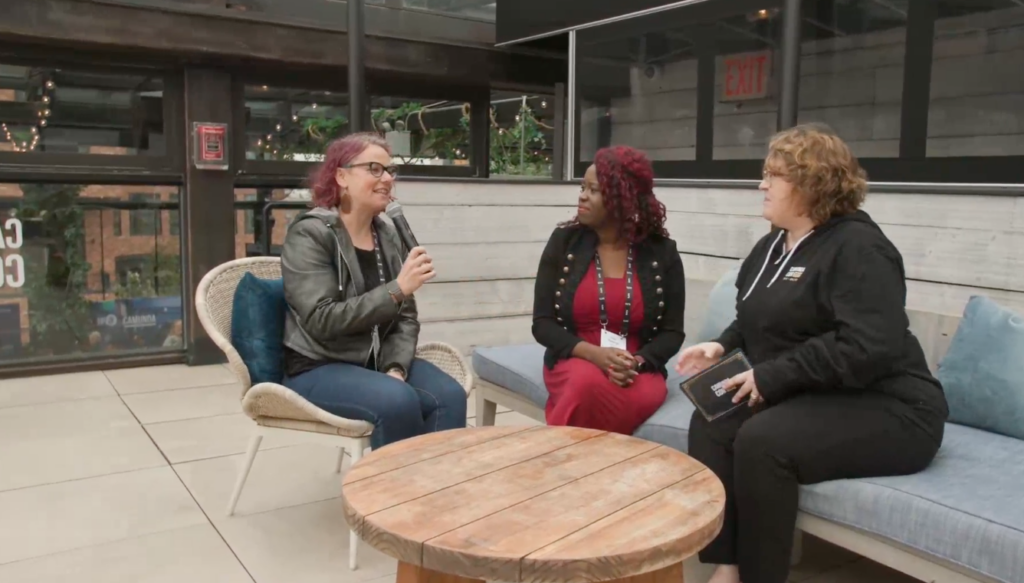
During the in-person break, our online attendees once again got special programming with a behind the scenes conversation with our keynote speaker, Nialy Makangu (they will be giving an inspirational talk closer to the end of the day – don’t miss it!). The conversation was led by Mary Thengvall, Camunda’s Director of Developer Relations and Amy Johnston, Camunda’s Principle Product Marketing Manager.
How To Use Workflow Orchestration To Improve Patient Experience and Outcomes
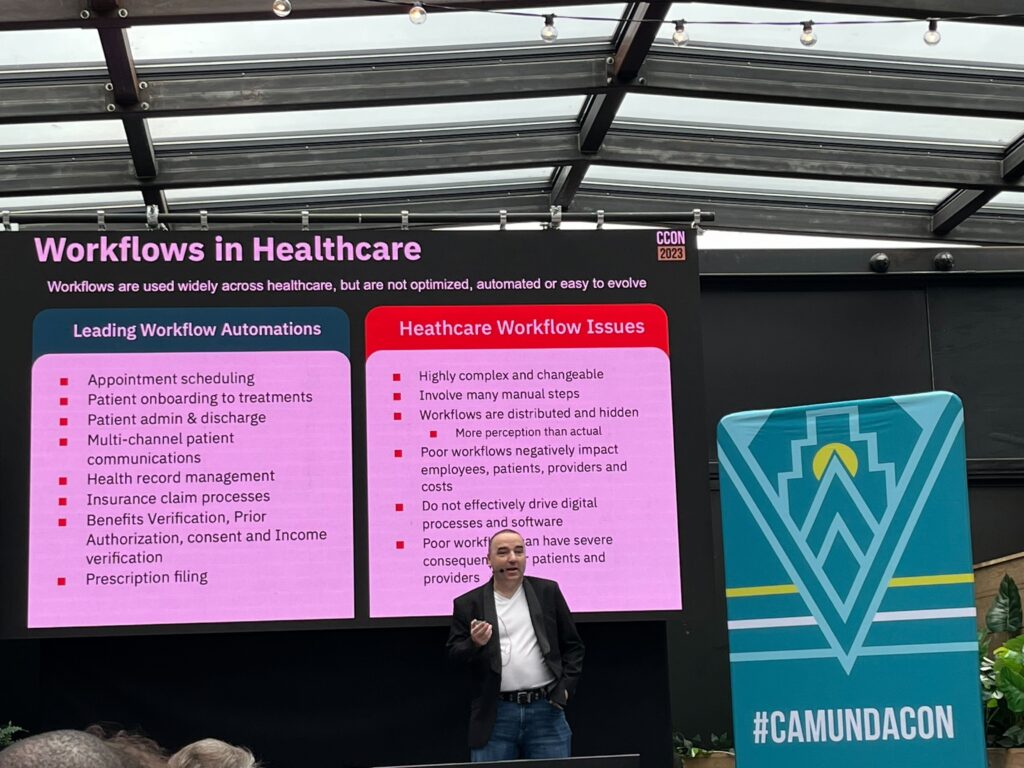
Continuing on the Roof Stage, Steve Gregory from Cardinal Health Sonexus took the stage. He talked about a key role his organization has in helping those who are uninsured or underinsured get access to care, and also about key technology challenges – for example, the continued criticality of the good old fax machine in healthcare processes.
Steve covered industry-driven trends as well as technology-driven trends effecting change, around personalized healthcare, telemedicine, automation, AI and more. He also talked to the numerous workflow automations needed in healthcare – as well as the challenges in getting there.
One thing Steve mentioned he loved about Camunda is that it helps everyone think in terms of processes or workflows, which can often be reusable. He shared his tips for helping increase adoption of Camunda in a new place, including overcoming internal resistance to change and legacy approaches. Steve suggested getting an early win involving all related roles of the business and building a community of practice. The simplicity of BPMN really helps – he was able to get product and business teams up and running on it and experimenting within weeks.
Today, Steve and his team has used Camunda to automate creating and rescheduling appointments, verifying benefits, digital enrollment and more (along with chatbot integrations). Camunda has helped create easy-to-understand, transparent, well-documented and reusable processes that make it easier to show value and get more and more teams on board. Steve also talked about how important process automation is to modern and advanced medical practices like cell and gene therapy.
Be sure to check out this recording to hear more about how process automation is making a difference in healthcare and to hear about where Steve wants Camunda to help Cardinal Health to go next, including additional workflows, cell and gene therapy and integration of AI.
Implementing Resilient and Cost Effective Human Task Orchestration Service at Scale on AWS
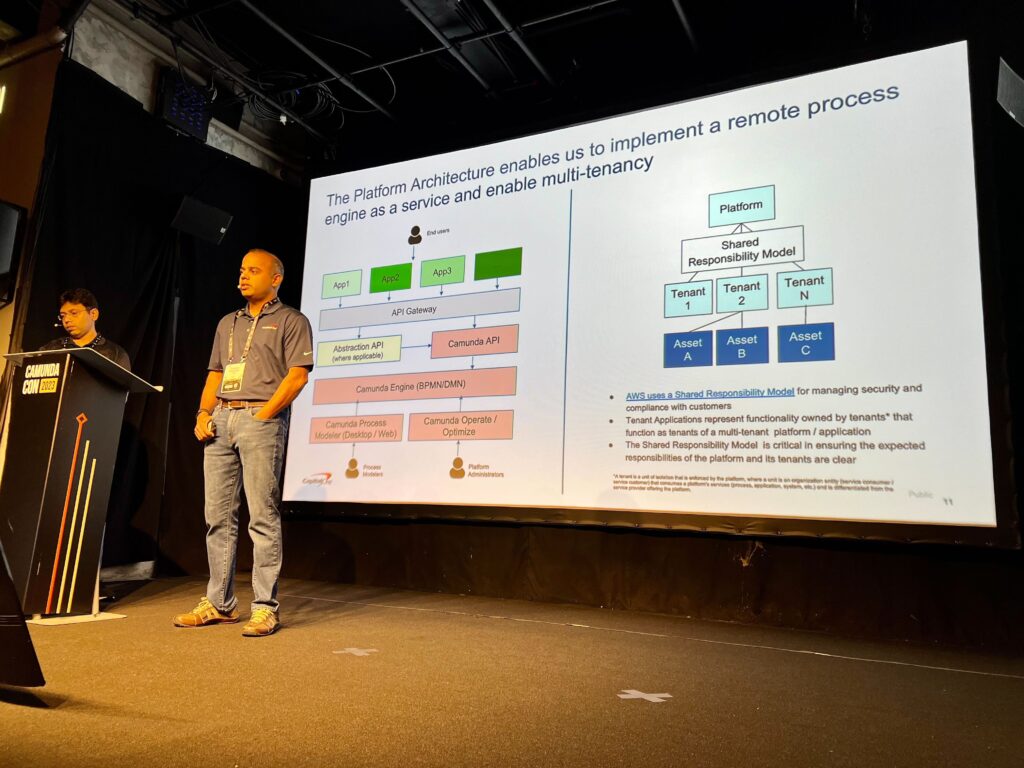
For this next talk I headed back down to the Main Stage to hear from Raghavan Sadagopan and Lakshmi Narayana Rasalay, experienced engineers from Capital One. Capital One has an extensive tech operation, with an open-source-first mentality and as the first big bank to go all-in on the public cloud.
Raghavan spoke about the difference between orchestrating system tasks and human tasks, and what Capital One felt it needed in order to effectively enable human task orchestration. Open source was a must, with an active and thriving community and full support for BPMN and DMN. The option to use a SaaS approach and multi-tenancy were also critical. Other criteria like analytics, audit tracking, connectors, task management, decision engine, process modeler and more were also considered. Camunda checked all the boxes ✅.
He then opened up a discussion into the platform architecture they use to implement a remote process engine as a service, before handing off to Lakshmi for a deeper dive into the AWS architecture and how they enable a scalable and high resiliency architecture. Raghavan then recapped the lessons learned from the process. He shared that a takeaway he’s gotten from sessions he’s watched so far at CamundaCon 2023 is around how to scale things across such a large company as Capital One and create an effective Center of Excellence – as he said, the handful of expert engineers for a specific solution just can’t scale by themselves.
Don’t miss this replay when it’s available to learn about how to handle human task orchestration using Camunda and AWS from a large organization that is doing this very effectively.
Don’t Miss These
I wasn’t able to attend these other sessions before lunch (the joy and the pain of having 30 sessions on two tracks), but Swaroop George of Cognizant gave a great talk on “Delivering the Best Patient Outcomes Through Value Based Healthcare Is Changing Pharma’s Approach to Customer Engagement” and Niko Vogel of AXA spoke about “From Legacy Application to a Modern Architecture With Camunda.” Digital transformation in the healthcare and pharma world is a huge topic (Steve Gregory talked about one angle of that as well above) and so important for improving the results for patients. Niko’s story about a legacy migration with zero downtime is also quite compelling. Be sure to check these replays out to hear their full stories.
Lunch and Bite-Sized Learning
It’s lunchtime for our in-person attendees. For our online attendees, there will be a special presentation and bite-sized learning session, plus the opportunity for networking through our online platform.
Sustainability, the Circular Economy and Digitalization – How to Realize a Use Case for a Digital Product Data Passport With Camunda

After a delicious lunch, Christine Brautsch and Tina Wiegand of Hof University led off the first session on the Main Stage about a Digital Product Passport (DPP). Why? The EU developed a program called the European Green Deal in 2019 with a goal of turning Europe climate-neutral by 2050. In addition to things like clean energy, a key component of the plan to achieve this is the “Circular Economy,” which means that products should be designed to be used and reused and generate as little waste as possible. The DPP is a way to share data about a product throughout its entire lifecycle, starting with the raw materials, manufacturing, the retail life, its repeated reuse and final future in a recycling center.
Needless to say, to do this correctly requires quite a lot of data from a lot of business processes from a lot of different organizations. The idea of doing this for every single product sold in the EU is challenging to say the least. But if it can be automated – and crucially, centrally orchestrated – this can become much simpler and more achievable. This is a really unique use case for process orchestration that will be relevant for many, many companies doing business in Europe in the near future.
Christine and Tina decided to start an experiment focused on the retail industry, which operates on the linear “Take, Make, Waste” model – according to Tina, only 1% of all textiles are ever recycled today. Today, the only information on a garment is the small care tag, which doesn’t have a lot on it and which consumers often cut off when wearing anyway. This makes it nearly impossible to recycle.
The biggest challenge for Tina and Christine was to understand the process. This made Camunda a natural choice to approach the issue, so they could use a BPMN model to gain visibility into the process and then automate the model. They visualized the entire linear process and then clustered it into four phases to reduce the complexity, then mapped DPP requirements to the process activities. However, it was still linear and lacked circular reuse, so they developed a DPP Hub platform that can house and transmit the data needed to create a loop – all through a QR code that can be added just like a care tag to any garment. Scan the QR code and you get all the details in the DPP for it.
Christine and Tina hope to extend the data available in the DPP to trace the details of the materials, the entire supply chain, the carbon footprint and best practices for recycling it, all in one centralized location. This can also be applied to industries far beyond the retail industry with the same principle.

It’s always fascinating to see new and innovative ways to use Camunda’s ability to effectively visualize and orchestrate complex processes, and this one could have a huge impact on an important initiative. This “process as a service” solution can even be offered on the new Camunda Marketplace.
GPT Meets BPM: AI-Driven Workflows in Camunda 8

I headed back up to the roof for the next session to hear Holisticon’s Bennet Krause talk about AI-driven Camunda workflows. After giving an overview of a painful process (manual customer service at a bike shop) and how large language models (LLM) work, he dove into how we can use it.
Bennet developed an open source project (camunda-8-connector-gpt) with task-specific Connectors for Camunda powered by LLMs. The “Foundational Connectors” include the Decision Connector (which can determine intention), the Extract Connector (which can grab relevant data), the Compose Connector (which can create a response), the Translate Connector (for translation) and a Generic Connector (for general purposes).
Next, we were introduced to “Agentic Connectors.” These autonomously interact with the outside world. As an example, the Q&A Retrieval Connector which can retrieve data from a vector database, with the possibility of independently running multiple queries for complex questions (such as comparisons). Another example is the Database Connector, which can query a traditional SQL database. Others include the OpenAPI Connector, Process Connector and Plan & Execute Connector.
Each time Bennet showed us a Connector, he explained how it could be added into the manual BPMN model of customer support to increasingly automate it, removing manual step after manual step. Really making the life of the bike shop’s customer support rep easier!
I wanted to grab an image of the model in action, but my images of the presentation screen came out with some unfortunate lines through it – but hopefully below you get the idea!

This was a very innovative way to use AI and LLMs in different ways directly within a BPMN modeler to automate user tasks away. Fascinating, and if you couldn’t catch it live, definitely worth a watch if you’re curious about what AI can already do for process orchestration today (not to mention where it’s going). You can even head to tinyurl.com/camundacon23 and try out his demo live for yourself!
Coffee break and Bite-Sized Learning
Time for those here in person to stretch their legs and get a drink. For those online, there’s another Bite-Sized Learning session to check out!
Improve experiences via Frictionless Customer Onboarding Journey for Banks using Camunda

The next speaker on the Roof Stage was Raj Saboo of Capgemini, who jumped right into the challenges facing banks in onboarding new customers. Key challenges include personalization (why do we have to re-fill so many forms?), identification/verification (IDV), and compliance checks. Raj explained and then demonstrated how AI services can help speed up this onboarding journey.
Using Textract and Rekognition from AWS Raj showed us how he could extract information from a driver’s license and use it to prepopulate a form in Camunda, and then verify an image match from a separate image to confirm an identity rapidly. A change like this can have tangible impacts – at one bank Raj cited a 40% increase in Net Promotor Score (NPS) from personalization, 30% less time taken for onboarding with frictionless IDV, and 25% less manual work for compliance.
Kalpesh Sharma and Bala Sundaram of Capgemini then talked more about the customer journey using process orchestration to manage microservices by mapping process nodes to microservices using Zeebe. Bala then took us through a live demo showcasing how effectively microservices can be orchestrated with Camunda. It was an interesting story of managing a complex yet critical process and how strong process orchestration can help make things easier and faster.
More great sessions taking place where I wasn’t
Once again, I couldn’t be everywhere, but these sessions were too good to leave out! Don’t miss these engaging talks.
Collaborating for Standards-Based Process and Decision Automation: The Partnership Between Camunda and OMG

Camunda has long been a leader and advocate for BPMN, and Camunda is part of the Object Management Group (OMG) that maintains it. This session by Camunda’s Marco Lopes & Falko Menge. This was a great discussion on the evolution of the BPMN and DMN standards, as well as the benefits of open standards including less vendor lock-in, more resilience to change and even opportunities to further your career.
Empowering an Omnichannel Banking Experience
Andreas Unterhauser and Dietmar Wieser, from Raiffeisen Information Service, gave a great talk about their omnichannel banking platform. They demonstrated how to seamlessly integrate multiple channels for a unified customer experience with Camunda at its core. Andreas and Dietmar share how the platform enhances customer satisfaction, operational efficiency, standardization and rethinking of end-to-end banking processes.
Revolutionizing Operational Decisions: A Medical Liability Insurance Case Study With the Camunda 8 Platform

Many companies are running legacy software and there are a lot of benefits to modernization. Tom Wilger and Tracy Hires from BP3 talk about the process of upgrading from mainframes all the way to the cloud, and explores the challenges experienced by a medical liability insurer and the significant benefits they achieved through decision automation and DMN with Camunda.
Building Trust: The Smartest Investment for a Productive Team

How do you build trust? Naily Makangu of Athena Leaders talked to us about how important trust is for teams. Yes there’s a dictionary definition of trust, but usually it’s more of a feeling, and trust is hard to build and easy to lose. If we don’t feel trusted – if your opinion is repeatedly ignored at work, for example – the feeling stays with us. Online, we try to “force” trust through contracts like the “terms and conditions” we’re all familiar with – but if that’s the only way you build trust on a team, it’s not going to work out. This makes sense to me – if I only trusted my teammates as much as I trust the apps on my phone, that would be a problem.
Integrity is essential for building trust, both for a person and a team. But integrity doesn’t mean perfection – part of it means that if mistakes are made, there’s an opportunity for growth, rather than finger-pointing. People need to feel safe to own mistakes and improve.
It also means caring about how others think and operate. Personalities could be different – some may be more meticulous in their thinking, or too straight-to-the-point, and how do you approach each person in a way that works for them and makes them feel trusted and valued? Cultural norms could be different – some could be used to very direct communication, others expect a different style, and how do you accommodate each? Conflict resolution is also important – if you let it go on too long, trust will erode.
One way to give yourself a vocabulary for understanding this, and to open a conversation without pointing any fingers, is through personality tests (Nialy highlighted DISC). But the important thing is to focus on respect, integrity and trust within teams.
This was a thoughtful talk on the importance of mutual respect, consideration and, of course, trust, in enabling productivity on your teams.
Panel: The State of Process Orchestration Maturity
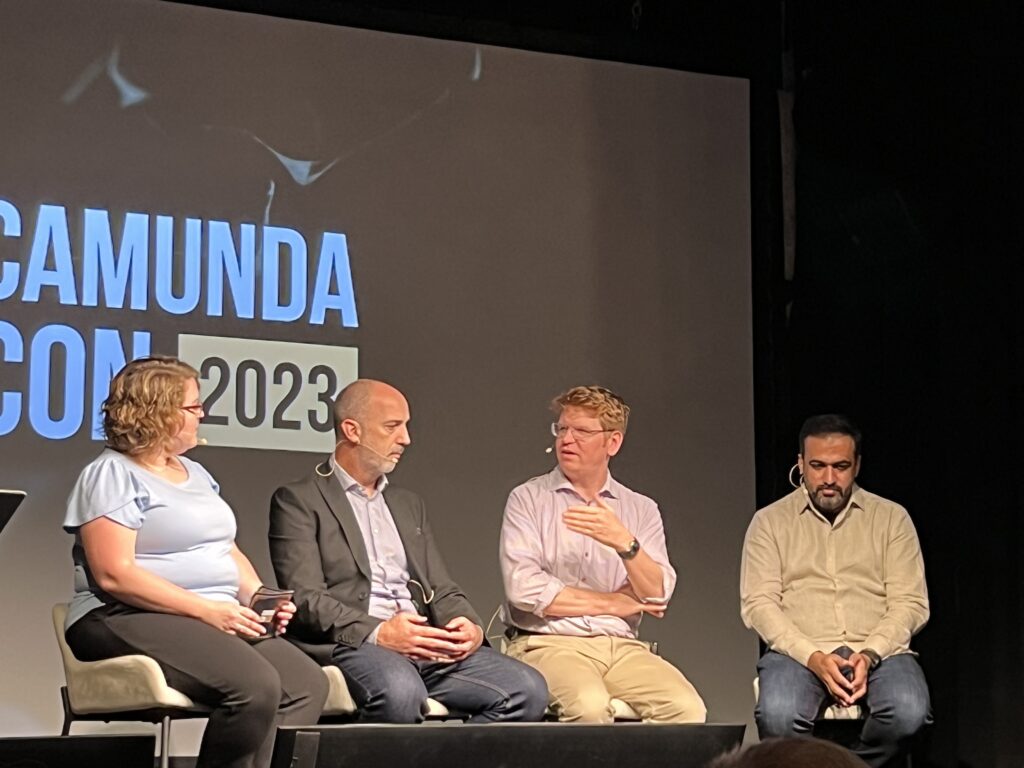
Camunda CEO Jakob Freund, Camunda, James Holt, the BPM CoE lead from NatWest and Rajesh Kumar Dharmalingam of Funding Societies sat down for a panel on process orchestration maturity, which has been a theme in this conference.
It was a fascinating conversation. When the subject came of measuring success, James talked about the importance of keeping customer value at the front of everything they do – he was excited to share how they were able to cut the time of a bereavement process for their customers in half, and how clear the impact that is on their customers. Rajesh mentioned that metrics like NPS can be important for a similar reason – its a great way to understand the value your product has for your customers and how happy they are with it.
Check out the full replay to hear thoughts on that and much more from Jakob, James and Rajesh.
Thank you and see you next year!
For those of us in person it’s time for a drink on the rooftop and to say goodbye. Thank you for attending, whether online or in person, and for sharing your beautiful selfies.

Next year we’ll be holding two CamundaCon 2024 events, one in Europe and one in North America. Look out for the replays of CamundaCon 2023 to be available as soon as next week, and can’t wait to see you next year (maybe twice?) at CamundaCon 2024!
Update: Did you miss CamundaCon, or just want to check out the sessions you couldn’t catch live? All replays are now available at the link below!
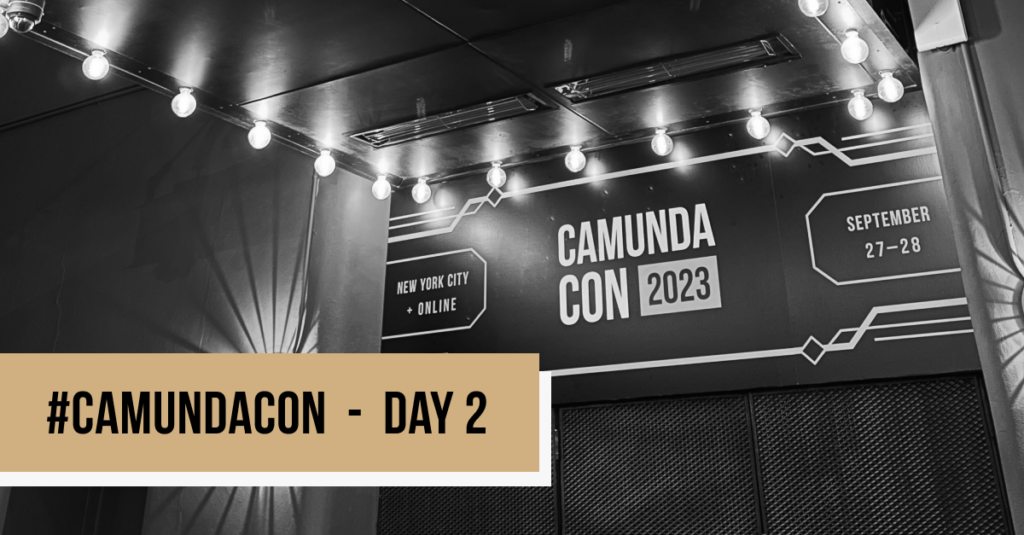


Start the discussion at forum.camunda.io